From the diary of false faith in the outside world.
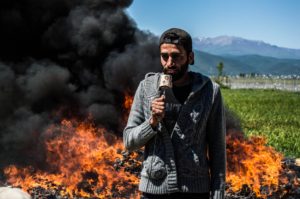
Last year during my presence on the Balkan migrant route, I struggled with a number of new roles. First I was a volunteer at the borders, then all of a sudden I was to direct a documentary, and then I became a journalist, whose job was to inform the public about everyday affairs in the form of personal diary reports.
I do not wish to talk about the instances when media have failed to report about migrants and refugees, nor how these issues are covered by the media (on this issue I recommend this great analysis). After a critical (self-)reflection of my own volunteering experience, I would rather consider the acts of motivation, and what is behind the media representation of misery and suffering. In this puzzle I would like to find a small piece of insight into our understanding of the worlds of suffering that are beset by wars or extreme poverty, when the actors of these forms of misery are perceived as “harbingers of bad news”, and are constantly blamed and punished for the content of the messages they bring.
No one puts their children in a boat, unless the water is safer than the land
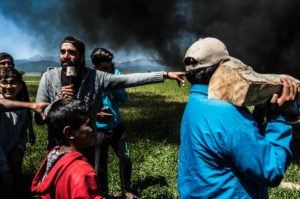

I remember to this day the effect the poem Home by Warsan Shire had on me.. I had just returned home from the road I had walked together with the refugees, so that I could bring the news about them in the form of a film. My motivation to inform the wide public and to notify them of these things rested, like in the poem, in the faith that this is the only way the outside world (a dreamlike notion of the existence of something beyond the epicentre of the staged suffering) could be confronted with its irrational fears and hatred, and so the political representatives would finally start to execute instead of negotiating endlessly.
Why does Europe, instead of solidarity and compassion with the refugees, have exactly the opposite reaction? Sociologist Bauman has offered an explanation – because they [the refugees] represent a collapse of order, which is “a state of affairs in which the relations between causes and effects are stable and so graspable and predictable, allowing those inside a situation to know how to proceed”. Because they reveal these insecurities to us, they can be demonised much more easily. By stopping them on the other side of our properly fortified borders, “it is implied that we’ll manage to stop those global forces that brought them to our doors”.
In one of the most important books of the 20th century, The Origins of Totalitarianism, Hannah Arendt uses the category of “worldlessness” (having been a stateless Jewish refugee herself) to define those conditions, when a person does not belong to a world in which they matter as human beings or as individuals. This seems to be equally resonant when describing the „plight“ of contemporary refugees, who have, thanks to dehumanisation, lost their faces, and have also become worldless.
Refugees are “worldless in a world that is spliced into sovereign territorial states, and that demands identifying the possession of human rights with state citizenship. […] In such a world, those people who are forced to flee intolerable conditions, are not considered to be bearers of rights. Forced to depend for their survival on the people on whose doors they knock, refugees are in a way thrown outside the realm of humanity, as far as it is meant to confer the rights they aren’t afforded. And there are millions upon millions of such people inhabiting our shared planet.” Therefore, my very faith in informing “my” world (or as refugees call it, the outside world) reflected in fact my attempt at returning them back to their “realm of humanity”.
That is where my faith in sharing the news with the outside world came from…
Parable 1. We should inform about what is happening here
Many times I was confronted with one question, which put me into the role of an interviewee by the migration actors that we had been depicting:
“Do you believe that your photos and videos will help put an end to our suffering in Syria?”
“Yes, I believe so, because when the public sees this, it won’t leave them indifferent, it’s bound to provoke some reactions. I should inform about what is happening here.”
The relationship between me and the refugees was therefore represented by a faith in the sense of informing the outside world that we shared. We believed endlessly both in the informational and emotional weight of the stories of misery, whose sharing would trigger some changes. So both the interviewer and the interviewees gave each other the best gift there is – help and cooperation. It was a picture of a dreamlike symmetry, but one that is always just a situational game of hidden inequality. However, I quickly overcame the dilemma.
I said I believed that sharing the news with the outside world made sense…
Parable 2. This is the only thing we can do
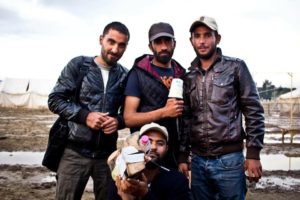
The days in Macedonia went by too quickly, so there was no time to ponder upon the pictures of the events, nor to evaluate or discuss them. It was only thanks to our mobile phones that we knew that it was 20th August 2015, a Thursday. We were headed with our parcels of humanitarian aid to the train station in Gevgelija. The border was closed those days. In spite of that, about a hundred refugees made it to Gevgelija via the basin of a nearby river. Most of them were deported back to Greece during the night. I will never forget the fear that lit in the eyes of the children, when I approached them in an attempt to calm them down. They thought I was from the border police. Then the refugees who waited to be deported made a kind of a human causeway, so that I can document their situation with my camera, the way they sat in a knot on the ground, surrounded by border police.
“Please help me, my whole family is dead.” I am able to articulate only “I can’t, I’m nobody in Macedonia, I don’t know anyone, who can help you. There’s nothing I can do!”
“Tell everyone about this, tell them everywhere, tell the people in television!”
“This is the only thing we can do…,” I answered, even though I knew that I was in no position to help the refugees.
Because I still believed that sharing the news with the outside world made sense…
Parable 3. I’d really like to answer you, but I’ve never experienced such things.
Once in front of the newly built registration camp in Gevgelija, I ended up being completely dazed. I had always thought that I was prepared for everything, I mean literally for everything, but when Hassan, with whom I was having a chat about the quality of local cigarettes, suddenly took my camera in his hands, and started interviewing me, I felt as if I had fallen into a black hole.
“How would you feel if I told you, that I have seen the death of tens of my friends? How would you feel in that moment, if it was YOU watching? What would YOU think? Come on, speak, it’s YOUR turn!”
“I’d really like to answer you, but… I’ve never experienced such things,” my words started draining from my mouth.
“We too have a voice, you know. You just need to hear it. You’re already here with a camera in your hands, so show this to everyone, and please put an end to this war, which took away everything we have, everything,” asked the man with tearful voice, and then he started telling another one of his stories, after which my hands started shaking. They still shake whenever I recall it…
“That’s why I’m making this film. I want to give voice to the people who have seen these horrible things, and spread it among as many people as I can.”
At the same time I realised that victims of wars and environmental inequality alhough are refugees, are also active players with their own agency. We seem to have forgotten that they perform in the same media circus as we do, only they are on the other side of the trapeze. And they know how to balance, to avoid falling from the trapeze. As if they want to show us, that there is no outside world. So I started to realise, that this faith that we can make changes happen, is only a necessity, something that keeps you going, your raison d’etre. Otherwise you can get lost inside you.
So I had to keep believing that sharing the news with the outside world made sense…
Parable 4. Idomeni is like a big theatre
There are actors, on the other hand, who were able to show in a subversive way, that our faith is blind. Photographer Martin Trabalík, for instance, captured a moment in Idomeni in Greece, which, in its subversive and emancipatory nature, is an excellent example of how the actions of the refugees can make us understand that the faith in the outside world, which is listening, is completely blind.
A couple of refugees, who were stuck at Idomeni, walked around the place of misery that held ten thousand people, with a camera made from a carton box and an empty bottle functioning as a camera lens, a microphone made from a tea cup covered with a domestic Syrian sock, and they were giving sarcastic comments to everything they saw.
Everyone is part of the media circus, where everyone films, interviews, and takes photos of everyone. However, the act of these people is much more profound than the attempts at artistic performance made by Ai WeiWei, for instance. The photographer has also left a gripping commentary: “Idomeni is like a big theatre. Everybody carries a camera, everybody has a smart phone, everybody takes pictures. Journalists, documentarists, volunteers and sometimes even the police. And of course the refugees themselves. On the one side they seem resigned with all that publicity that changes nothing, on the other side they find their ways to point out the craziness of the whole situation.”
This group of people, ironically called Refugees TV, succeeded in showing through a subversive replay, how the journalism industry is striving with all its might to bring news of suffering to the outside world, and they did so by critically opposing the fact that the international community has rendered them invisible just by not listening to them.
“We want to show the world this tragic situation with sick children, and educated and talented people hopelessly sleeping on the roads that has become a reality of our lives. Our aim is to record this sarcastically as the international political news keep talking about us yet without any actions,” they wrote on Facebook.
The subversiveness of their action may have been diminished when they were presented with a “real” camera, and now are acting as “real” reporters, but the emancipatory spur of the initial act seems to have remained: they refused point blank to become objects of our technical miracles, thus emancipating themselves in the game that is the journalist industry, which does have its part in the commodification of suffering. Not only do they want to tell their stories on their own behalf, but they seem to radically change the perspective by putting the “international guardians” in the position of “objects” – these being employees in humanitarian organisations and volunteers, who are thrown in their black holes by the same questions as I: “Imagine you are a Syrian refugee in this camp, what would you be able to do?”
Despite their subversive project, and the persevering emancipatory potential it produced, at the end of the day Refugees TV returned to the faith in the outside world. “It is important for us to let our voices, and those of the other Syrian refugees, be heard by the world… so we can finally get some real help to open the borders for us, so we can go live a normal life like every human being deserves to have.”
Interestingly enough, it helped me regain my own faith…
Parable 5. Stripping the false faith in the outside world naked
It was partly due to the two of the most powerful films I have seen in the past few years – the Oscar-winning Hungarian drama directed by László Nemes, Son of Saul, and Renzo Martenze’s artistic interventions in his documentary Enjoy Poverty. I believe that these two films are connected by the red line saying that faith in the outside world, is a false faith.
No one listens to you, Saul!
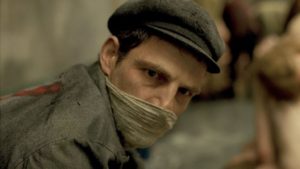
Son of Saul recreates a number of events that took place in Auschwitz in 1944. The main character works as a Sonderkommando member, whose task is to burn the dead. There is a scene in the film, when he tries to smuggle a film and a camera in the camp, in order to take photos of the atrocities committed inside, and then smuggle the photos outside for the purpose of attracting attention and receiving some sort of help.
The scene is based on a real story. Four Photographs from Auschwitz were hidden and smuggled out of the camp and given to a Polish resistance fighter. The purpose of the pictures was to show the reality of Auschwitz and to make it accessible for the rest of the world.
I then remembered Idomeni and Refugees TV. Yes, a picture is worth a thousand words, but as we can see even today in Idomeni, or from the story from WWII, the outside world is simply not listening.
Enjoy poverty, you Congo paupers!
![enjoypoverty__ge[2]](https://lefteast.org/wp-content/uploads/2016/05/enjoypoverty__ge2-300x190.jpg)
Moreover, as Renzo Martenz showed us, not only is it not listening, but it seems to be building its economic capital on the false faith itself. Dutch artist Renzo Martenz spent two years in the poorest and most violent areas of the Congolese interior. There he attempted by the means of artistic intervention, and from the position of a “white God”, „a prophet“ of international protection, to recruit the locals, whom war and poverty had reduced to misery. Doing so, he opposes the other international protectors and humanitarian organisations, as well as journalists. Furthermore, he considers them accomplices of a system that creates structural inequality and violence.
He takes the humanitarian perspective, the dream about outside-world protectors, and he turns it upside-down by the means of a most radical gesture – by teaching the locals that there is no outside world, because no one outside is interested about them. This emancipation programme teaches them to sell the most valuable (and only) commodity they have in the media and humanitarian industry – extreme poverty itself. Local photographers should stop taking photos of happy scenes, and instead they should aim their cameras at situations of shock – they should show in as much detail they can manage, the bones on the fleshless limbs of their undernourished children, who die on screen.
Though it is possible that these scenes will make you cry your eyes out, I am confident that they also have the power to illuminate the hidden – the economic machinery behind the media industry. This is especially true when Martenz tries to confront foreign reporters with the crucial question: “who should claim the money from the photos of undernourished people? Or the mutilated, undernourished bodies? Who should claim the one commodity left to the locals, their poverty?”
Photojournalists have no control over the context in which their photos would be used, which is one of the important “side effects” of the journalism industry and of the commodification of misery. The initially good faith of the journalists to “inform” about the suffering of the people can then be turned upside-down (and used as an argument for the thesis, that Europe is invaded by “able-bodied men with smartphones” dressed in modern clothes, and so on).
Moral from a fairy tale by H. Ch. Andersen: Our world isn’t wearing anything at all!
What Martenz does is to directly attack the commodification of misery in the world, when sharing the photos and news from the places of despair brings neither changes nor solutions to the reasons these problems stem from, but it only enhances the structural inequality between the journalist and the depicted, between the world of human misery and the outside world. He stumbled upon his role as “our ambassador” in an auto-referential way, when he returned to Congo after the release of his film, and he told the locals, how it had helped him establish a well-respected position in the community of contemporary Western artists. The locals gave him a big applause, and you ask yourself, what is going on here.
Can there be a stronger gesture of the production of structural inequality and violence, and at the same time a representation of false faith in the outside world? Martenz stripped our world naked, and so taught us the powerful lesson, that every fan of Anderson’s fairy tale The Emperor’s New Clothes knows off by heart: “But [our world] isn’t wearing anything at all!” This is a far more suitable way of evaluating the situation than just saying: “The tailor did a very good job indeed!”
Therefore, he literally shows us how this exploitation of misfortune occurs: intellectual discussions about poverty are being held in his/our artistic world, carriers of artists (but also journalists, scientists) are constantly being produced, who use their capital only to fuel their own economy. You can literally see how most of these debates about the misery of the others end: in a gentrified neighbourhood full of creative minds (who have replaced those who had paid the biggest price for the rising cultural capital – the original inhabitants who can no longer afford the rent), or a glass of overpriced whisky in the bar, because this is what the international saviour drinks: a fiery beverage which is the perfect image of our world’s reality, the outside world.
The price of eternal vigilance is indifference
Only someone who is a hardcore fan of The X-files (The Truth Is Out There) is capable of believing that by media sharing, or by sharing the stories of misery or of shamelessly plain injustice, we can improve the situation of those who suffer. As Marshall McLuhan points out in Understanding Media: the price of eternal vigilance is indifference.
And there is always a good excuse: today it is Prince dying, tomorrow it is… (feel free to end the sentence as you like). No one listened even when the shocking “Caesar photographs” appeared in public to uncover the hell of Assad’s regime in Syria: “We thought our work would mobilise public opinion. The photos were shown to the EU, to Congress in Washington, to the UN Human Rights Council. But the politicians want to turn the page and negotiate with Bashar al-Assad. How did we get to that point?” You know the answer.
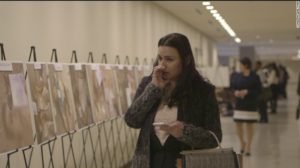
We are locked in…
The only way to get out of this giddy-go-round is, I believe, to ask more and more questions that are concerned with the acknowledgement, that we are locked in a system, which builds its commodification, as well as its capital in “our” world, on suffering alone. There is no point in looking for solutions (which 1/ will not work, and 2/ do not exist), but we need to find ways, like Martenz did, to expose the production of hidden aspects of (media) reality.
Let’s ask ourselves, then: how can we bring the light on other aspects of reality? As Martenz’s intervention tends to show, one of the ways to expose this relationship between the place of misery and the dreamed-of world outside, is critical art. He just needed to show in an auto-referential way, what kind of economy is the contemporary imagery of visual representation supported by.
… and that’s why we were also the battlefield
Only the battles which aren’t even begun are lost at the start. (Madjiguène Cissé, spokesperson for the Sans-Papiers in France)
War is not only waged by kalashnikovs on the fields, but there is also an imaginary war taking place in the fields of politics, economics, and humanitarianism – one example is the war of the ideas of humanitarianism. We are all part of the battlefield of today, because we all fight for the status of good/bad guy, for decisions such as whom the barrage should be aimed at, whom should we help, or who deserves our help the most.
So Martenz gives a personal perspective – if we are the battlefield of this imaginary war, then maybe it is not important to ask undernourished people or refugees the question: “how do you feel?”, because, according to him, in the end it does not count anyway.
The real question the should be: how do we feel, when we see „them“ suffer? What does “their” misery mean to us, and what does it say about us? And in what way we spread what we feel?
The phenomenon that we show, we analyze and then we represent visually, is given by our instruments of recording (camera), which are dominating the economy game. We must think of ways to draw attention to the unseen, to reflect on the economics of the relationship between representation and the institutions, which dictate the frames of visual representation in the media, so as to brake the usual pattern of journalist-actor-story-its representation.
We should not only be raising awareness among common people about the misery of others, but we should also point out the whole agenda of the process, including our ability to go wherever and whenever we want, ask why we watch these images and what effect they have on us, and how we cannot do anything about them. We should concentrate on our own ideas of the reality of the people in misery: how is it structured, commodified and represented by those, who inform about it? What the world of media does is producing truth for us (“but I saw it on TV”). If the image is evidence of the truth, there is a danger of neglecting its construction in its own fatality.
Politics of sympathy: humanisation vs real inequality
I believe that the abovementioned economics relies on our (dis)ability to imagine the full context of the reality visualised by photography or film. However, the effort to humanise the miserable and spread their story with the sole aim of evoking empathy by giving the dehumanised mass of refugees individual faces, cannot be the only way about it. This approach has its limits: “It seems like a waste if photojournalism just shows us broken, bleeding bodies, interspersed with images of ‘everyday life’ so that we can feel good about knowing that people experiencing violence are ‘just like us’,” Rafiqui aims a blind shoot in the dark.
Journalists tend to use victims’ faces as well as their stories only as some sort of stuffing, as evidence, or as compulsory illustrative decoration of words. Ultimately it is always we who speak on the behalf of the refugees on the shared photos, and by doing so deny them the right to be an equal object.
This is exactly why we should try the opposite approach – of admitting and showing the economics and politics of these relationships, which enables us to take photos or videos in certain places of misery, thus revealing the harsh reality of real inequality.
The mere humanization seems to be a cul de sac: journalism, which is supposed to cover conflict in an “eternal present” in which assertions of universal humanity are meant to arouse outrage, in fact clouds our understanding of real inequality.
Maybe this is the reason that nobody listens.
Michal Pavlásek, Ph.D. is social anthropologist, university teacher, freelance journalist and documentarist, Turkish coffee lover, researcher at the Institute of Ethnology of the Czech Academy of Sciences, Co-founder of Anthropictures – flexible association of social scientists providing independent field research. In his research focuses on migration and multuculturalism. Some of his writings you find here: https://cas-cz.academia.edu/MichalPavlasek. Contact: here.

